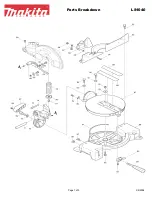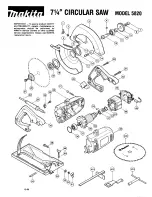
8
| English
Temperature monitoring/overload protection indicator
The red LED indicator helps you to protect the rechargeable
battery against overheating and the motor against overload.
If the LED indicator is lit up
permanently in red
, the temper-
ature of the rechargeable battery is too high and the power
tool switches off automatically.
– Switch the power tool off.
– Allow the battery to cool down before you carry on work-
ing.
If the LED indicator is
flashing
red
, then the power tool is
blocked and will switch off automatically.
Pull the power tool out of the workpiece.
The power tool will continue to work as soon as the blockage
is rectified.
Recommendations for Optimal Handling of the
Battery
Protect the battery against moisture and water.
Only store the battery within a temperature range of −20 to
50 °C. Do not leave the battery in your car in the summer, for
example.
Occasionally clean the ventilation slots on the battery using a
soft brush that is clean and dry.
A significantly reduced operating time after charging indic-
ates that the battery has deteriorated and must be replaced.
Follow the instructions on correct disposal.
Assembly
u
Remove the battery from the power tool before carry-
ing out work on the power tool (e.g. maintenance,
changing tool, etc.). The battery should also be re-
moved for transport and storage.
There is risk of injury
from unintentionally pressing the on/off switch.
Inserting/changing the saw blade
u
When fitting or changing the saw blade, wear protect-
ive gloves.
Blades are sharp and can become hot when
used for prolonged periods of time.
u
While replacing the saw blade, ensure that the saw
blade receptacle is free of material residue, e.g. wood
or metal chips.
Selecting the saw blade
You will find an overview of recommended saw blades at the
end of these operating instructions. Only use saw blades
with a 1/2" universal shank. The saw blade should not be
longer than required for the intended cut.
Inserting the saw blade (see figure B)
Turn the locking sleeve
(3)
approx. 90° in the direction of
the arrow and hold it firmly. Push the saw blade
(1)
into the
saw blade receptacle
(12)
. Release the locking sleeve again.
u
Check that it is seated securely by pulling the saw
blade.
A loose saw blade can fall out and lead to injuries.
For particular jobs, the saw blade
(1)
can also be flipped
180° (teeth point upwards) and refitted.
Removing the Saw Blade (see figure C)
u
Let the saw blade cool down before removing it.
There
is a risk of injury when touching the hot saw blade.
Turn the locking sleeve
(3)
approx. 90° in the direction of
the arrow and hold it firmly. Remove the saw blade
(1)
.
Dust/Chip Extraction
Dust from materials such as lead-containing coatings, some
wood types, minerals and metal can be harmful to one’s
health. Touching or breathing-in the dust can cause allergic
reactions and/or lead to respiratory infections of the user or
bystanders.
Certain dust, such as oak or beech dust, is considered carci-
nogenic, especially in connection with wood-treatment ad-
ditives (chromate, wood preservative). Materials containing
asbestos may only be worked by specialists.
– Provide for good ventilation of the working place.
– It is recommended to wear a P2 filter-class respirator.
Observe the relevant regulations in your country for the ma-
terials to be worked.
u
Avoid dust accumulation at the workplace.
Dust can
easily ignite.
Operation
Starting Operation
Switching On and Off (see figure D)
To
switch on
the power tool, press the lock-off switch to the
left
(6)
first. Then press the on/off switch
(7)
and keep it
pressed.
The worklight lights up when the on/off switch
(7)
is lightly
or fully pressed allowing the work area to be illuminated in
poor lighting conditions.
To
switch off
the power tool, release the on/off switch
(7)
.
Then press the lock-off button
(6)
to the right again.
Controlling the stroke rate
You can variably adjust the stroke rate of the power tool
when it is on by pressing in the on/off switch
(7)
to varying
extents.
Applying light pressure to the on/off switch
(7)
results in a
low stroke rate. Applying increasing pressure to the switch
increases the stroke rate.
The required stroke rate is dependent on the material and
the work conditions and can be determined using practical
tests.
It is recommended that you reduce the stroke rate when
placing the saw blade on the workpiece and when sawing
plastic and aluminium.
During prolonged periods of use at a low stroke rate, the
power tool may heat up significantly. Remove the saw blade
and let the power tool run at the maximum stroke rate for
around three minutes to cool down.
1 609 92A 74L | (07.12.2021)
Bosch Power Tools









































